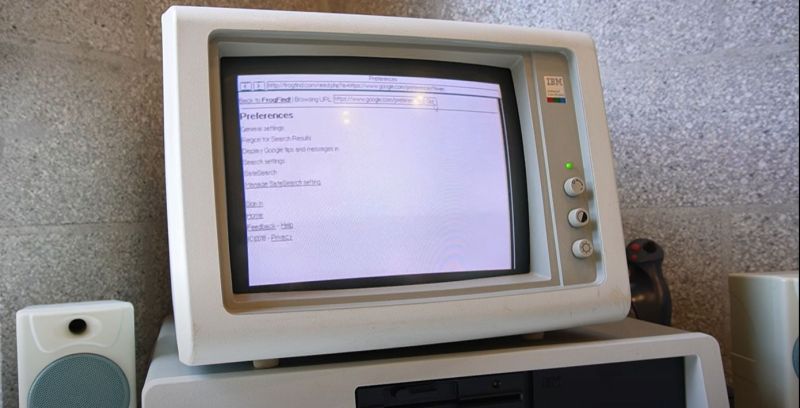Do you ever sit at your 1981 vintage IBM PC and get the urge to pop onto that newfangled ‘WWW’ to stay up to date on all the goings-on in the world? Fret not, because [Al’s Geek Lab] has you covered with a new video (also embedded below), which you will unfortunately have to watch on a device that was made at the very least in the late 1990s. What makes this feat possible is a miniscule web browser called MicroWeb, created by [jhhoward], that will happily run on an 8088 CPU or compatible, without requiring any fiddling with EMS or similar RAM extensions.
Of course, you do need to have some kind of way to actually connect to the World Wide Web, which can be an ISA network expansion card, EtherSlip, as well as using a thin client as a network bridge with some Serial Line Interface Protocol (SLIP) action. Of course, some limitations exist, in that graphics and CSS are not rendered, JavaScript is totally off-limits, and for HTTPS-only websites a workaround like retro-proxy has to be used as TLS encryption would be completely unusable on a couple-of-MHz-CPU.
There’s also the FrogFind service, which will helpfully strip down a target website down to its barest HTML essentials, along with the 68K News site that strips down Google News, so that you can enjoy the WWW in its text-based glory as it would have looked in the early 1980s.
(Thanks to [Stephen Walters] for the tip)















I have agreed with myself not to watch any youtube video that contains a surprised face in the thumbnail… (So that’d be 90% of youtube nowadays i think. *surpised face* o.o)
It’s kind of ironic that new technology (internet, www) looks more dated on vintage PCs than then-current technology did look on them. Back in the late 80s, my father had got a copy of Amaris BTX decoder, to participate the colorful BTX service. The service wasn’t perfect by any means, but had animation, little graphics, color gradients etc. And now in 2023 we’re celebrating the 1970s experience. It’s kind of ironic, isn’t it? The more technology advances, the farther we goo back.
That being said, congrats to writing the MicroWeb browser. Considering how bloated the internet has become, it’s quite an achievement for sure. Kudos.
I agree. I think if Windows 12 looked like 3.11 people would ooh and ahhh. The farther we go back indeed. 900 mini apps that do one thing reminds me an awful lot of an old hard drive program directory lol. Standalone vs enmeshed I guess is not the same but I had the same feeling. Who knows an all text browsing experience in 3030? I find most of my clutter drops the second I turn off java since it has been perversed to just be an ad injector these days lol.
Not sure if possible with ram requirments but would love to see this working on esp32 boards. Would be a super lightweight computer with lightweight browser.
ESP32 runs Windows 3.0 thanks to FabGL, so why not web browser?
What’s this? A device not just being a dumb terminal to a modern machine, and is actually online?
Now that is actually interesting
Actually, this used to be normal.
The C64 WebIt and many early internet set-top boxes ran on DOS on a 486 level processor.
But to be fair, they had proper VGA graphics rather than CGA.
Even back in the 80s, CGA didn’t meant the minimum requirements for most online services.
An Amiga with 32 colors on screen was bare minimum if no hardware decoder was available.
The MicroWeb browser could make good use of an IBM PGC.
640×400 @256c would be sufficient.
The PGC also has its own x86 processor to do the graphics intensive work.
There was no web in the early 80s. Early 90s, perhaps?
The world wide web (www) was being available since early 90s.
Mosaic was among the first known browsers to public.
Gopher was an alternative to the web at the time.
The internet/Arpanet was accessible in the 1980s, but limited to universities and other institutions. It was made public in the early 90s.
That being said, the internet wasn’t the only kind of network (internet=interconnected networks).
There were other networks, small and big. Like those X.25 networks, often based on existing telephone networks.
These X.25 networks were also connected to each other, but via gateways, not in a criss-cross fashion like the internet.
These were still independent networks. Islands, so to say, with bridges connecting them.
Those X.25 networks were the basis for early online services, often.
Back in the 80s, there was CompuServe for example. Or later on, Q-Link (ex PlayNet), GEnie, Prodigy etc.
Or Videotex (no -t at the end). Videotex family consisted of Prestel in UK, Teletél (Minitel) in France and BTX in German speaking countries.
These services all were very ambitious, even way back in the 1980s.
The MicroWeb experience wouldn’t have won a flower pot back then, even.
– No offense, Mosaic was similarly limited, no need to be ashamed thus.
The early online services rather looked like computer games or CeeFax/Teletext broadcast service on an analog TV of the 90s.
Here’s an example of early BTX, because it’s from my home country.
https://www.youtube.com/watch?v=1fRpnFoYfEU
Here’s Quantum-Link (Q-Link) for C64/C128 users.
https://www.youtube.com/watch?v=SHo3qjpDsm4
https://web.archive.org/web/20090219004306/http://www.qlinklives.org/qlink-old/Memories/Remember_Q-Link/remember_q-link.html
https://web.archive.org/web/20080211222159/http://dsgames.net/qlink/q-link/pictures.htm
GEnie radio ad: https://www.youtube.com/watch?v=NF0xcsKl7u4
Of course, these were online services owned by companies/federal agencies, not the big, free (?) internet.
But the underlying technology could have been used on the internet, as well.
For example, CEPT pages as used by Videotex family. Or Forums as used by AOL/CompuServe.
That’s my point here, more or less.
The pre-internet days weren’t plain ASCII, they were colorful.
I’m waiting for a browser that I can run on my CP/M 2.2 (Z80) machine! :-)
Thanks for the link to Frogfind!
elpis.ws works with it! )) and web 1.0 hosting too